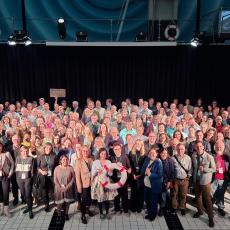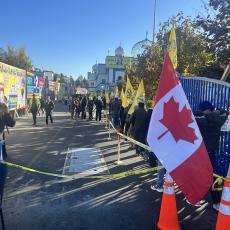As I write this, Russian troops reportedly are moving north through the Odesa oblast, or region, toward the river Kodyma, along which sits a town called Balta.
As I write this, Russian troops reportedly are moving north through the Odesa oblast, or region, toward the river Kodyma, along which sits a town called Balta.
This is not new territory for Balta, which like much of Ukraine has been contested over centuries of wars. But in recent years, Balta has actually broken a lot of new ground, at least when it comes to the practice of citizen-centered democracy. In 2016, Balta adopted participatory budgeting, an innovative process—originated in Brazil—in which citizens rather than officials determine their local budget. Balta also gave its young people their own governing council and a decision-making process to influence local policies.
Democracy, in its essence, is everyday people governing themselves. Such self-government happens most often at the local level, which is why countries tend to get more democratic when they decentralize.
Since the 2014 Maidan revolution, Ukraine has been among the more rapidly decentralizing, and democratizing, countries on Earth.
This context is crucial to understanding what is now at stake in Eastern Europe. The war is being described as a conflict between Russia and Ukraine, between Russia and the West, or between Vladimir Putin and Volodymyr Zelensky. But it’s really a clash between two of the most powerful trends in worldwide governance: increasing authoritarianism in nation-states and increasing democracy in our local communities.
In other words, Ukraine is now a battlefield where the international democratic recession meets the local democratic expansion.
Balta’s advances in local democracy are representative of this shift toward greater local power and responsibility in 21st-century Ukraine. A generation ago, Ukraine was a post-Soviet state, with a centralized government conducting top-down rule of 24 oblasts, and nearly 500 rayons (territorial units of about 50,000 people). Localities—including larger cities and nearly 12,000 hromadas, orlocal communities—could hold elections, but their officials had little influence over local affairs.
In this century, and especially in the last eight years, Ukraine has devolved power to those local communities, more than 90 percent of which have fewer than 3,000 people. For many smaller hromadas, Ukraine authorized amalgamation—mergers of small communities into larger municipal units, called “amalgamated territorial communities,” which would have enough heft to provide services and lead economic development.
To incentivize these mergers—towns made rich by gas or property taxes sometimes were resistant—amalgamated communities were given a greater share of both national and local budgets, new power to impose local taxes, and greater responsibility for education, health care, transportation, social programs, and agricultural land. To improve governance, these communities were authorized to experiment with democratic tools like participatory budgeting; in the past year, Ukraine has also advanced legislation permitting more popular referenda.
In a politically divided Ukraine, this devolution of local power had support across the spectrum, for a couple reasons.
The first was positive, and driven by economics. Putting more money and power in localities was seen as the best bet for addressing poverty and inequality, and developing Ukraine in a balanced way that would make it a better fit with the rest of Europe, which has strong local governments.
As I write this, Russian troops reportedly are moving north through the Odesa oblast, or region, toward the river Kodyma, along which sits a town called Balta.
This is not new territory for Balta, which like much of Ukraine has been contested over centuries of wars. But in recent years, Balta has actually broken a lot of new ground, at least when it comes to the practice of citizen-centered democracy. In 2016, Balta adopted participatory budgeting, an innovative process—originated in Brazil—in which citizens rather than officials determine their local budget. Balta also gave its young people their own governing council and a decision-making process to influence local policies.
Democracy, in its essence, is everyday people governing themselves. Such self-government happens most often at the local level, which is why countries tend to get more democratic when they decentralize.
Since the 2014 Maidan revolution, Ukraine has been among the more rapidly decentralizing, and democratizing, countries on Earth.
This context is crucial to understanding what is now at stake in Eastern Europe. The war is being described as a conflict between Russia and Ukraine, between Russia and the West, or between Vladimir Putin and Volodymyr Zelensky. But it’s really a clash between two of the most powerful trends in worldwide governance: increasing authoritarianism in nation-states and increasing democracy in our local communities.
In other words, Ukraine is now a battlefield where the international democratic recession meets the local democratic expansion.
Balta’s advances in local democracy are representative of this shift toward greater local power and responsibility in 21st-century Ukraine. A generation ago, Ukraine was a post-Soviet state, with a centralized government conducting top-down rule of 24 oblasts, and nearly 500 rayons (territorial units of about 50,000 people). Localities—including larger cities and nearly 12,000 hromadas, orlocal communities—could hold elections, but their officials had little influence over local affairs.
In this century, and especially in the last eight years, Ukraine has devolved power to those local communities, more than 90 percent of which have fewer than 3,000 people. For many smaller hromadas, Ukraine authorized amalgamation—mergers of small communities into larger municipal units, called “amalgamated territorial communities,” which would have enough heft to provide services and lead economic development.
To incentivize these mergers—towns made rich by gas or property taxes sometimes were resistant—amalgamated communities were given a greater share of both national and local budgets, new power to impose local taxes, and greater responsibility for education, health care, transportation, social programs, and agricultural land. To improve governance, these communities were authorized to experiment with democratic tools like participatory budgeting; in the past year, Ukraine has also advanced legislation permitting more popular referenda.
In a politically divided Ukraine, this devolution of local power had support across the spectrum, for a couple reasons.
The first was positive, and driven by economics. Putting more money and power in localities was seen as the best bet for addressing poverty and inequality, and developing Ukraine in a balanced way that would make it a better fit with the rest of Europe, which has strong local governments.
That’s not a blind hope. It’s history. The horrors of nation-state autocracies have long inspired the desire for local self-government, just as the weakness of democratic systems offers openings for dictators. Big authoritarianism and little democracy go together, like darkness and light—a reality famously recognized by the Ukraine-born Russian writer Mikhail Bulgakov in his classic Stalin-era novel, The Master and Margarita.
The plot is driven by a visit from the devil to the Soviet Union. “What would your good do if evil didn’t exist,” Satan asks an evangelist-writer, who is full of despair, “and what would the earth look like if all the shadows disappeared?”
This was originally published at Zócalo Public Square, an affiliate of Arizona State University.




